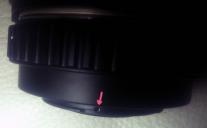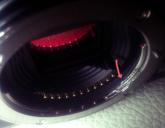
It allows to keep PV going, with more focus towards AI, but keeping be one of the few truly independent places.
-
Ok that makes senses. Anytime you put a speed booster or filter on the lens you increase the chance of degrading the image. I am really picky when it comes to image quality so when I am in the super anal mode I will remove any filters that I have on my lenses and shoot without any filters. I have a B+W filter on my 85mm prime and will take it off sometimes to get the best image quality. That is pretty anal but I do notice small little details in the image quality without the filters.
I looked at some of the images that you shot with the RJ looks good. I would not shoot landscape or the like with any of the speed boosters. I don't leave the speedbooster on the GH2/GH4 all the time, I only use it to try and achieve a shallower depth of field, wider field of view or to save a stop of light. Unfortunately there is no free lunch with the speed boosters and there is a degradation in quality with all of the speed boosters so this is why use it sparingly. I did not test BOKEH with the speed boosters but I am sure that is probably has some type of effect on that as well
The other thing to consider is maybe the lens and or speed booster is decentered. This will have the same type of effect on the image were basically one side or portion of the image will look like it is out of focus. I purchased a brand new Tamron 70-200 F/2.8 VC that had major decentering, in fact it had the worst decentering that I have seen from any lens that I have purchased to date. My Nikon 70-200 F/2.8, 85mm, and 50mm lenses are spot on with no decentering issues. Anyways just something to consider in regards to what you have mentioned because there are a lot of variables.
-
@inukhiphop I had forgotten to take this into account, thank you for bringing it up! Im sure this accounts for some of the issue Im seeing. I did another test and noticed that the image clears up dramatically by f/5.6 in the corner, which means that the lens turbo must not be causing much of the issue Im seeing. It probably has a minor effect especially towards the edges, but maybe I should just stop shooting wide open!
@azo it very well could just be a bad adapter, but I'll just live with it for now. :) I would really love to directly compare my copy to a metabones. Would be interesting to see the difference.
Since I dont have any other lenses to test on it, Ill just chalk it up to crappy coma-filled corners of the AI lenses.
-
it very well could just be a bad adapter, but I'll just live with it for now. :) I would really love to directly compare my copy to a metabones. Would be interesting to see the difference.
Instead of so much talking, it is just better to contact and make exchange if you think it is soft in some part. Period. No "may be" or anything like it. Just before make normal test with different lenses.
-
RJ Lens Turbo with Samyang 16/2.0, Kiron 70-200/4.0, Nikkor-S 50/1.4. Panasonic G6.
-
@saksofon Your works with the little G6 are incredible. In particular I like the cold color look, do you sue a prticular profile/grading workflow?
-
@albertz Thank you! We use LUTs in SpeedGrade - M31, Vision X and other.
-
@albertz great stuff. Do you shoot everything in natural at -5 and then simple apply an osiris lut like m31 or vision x? in speedgrade can you choose the strength in percentage of how much the lut is applied to the footage?
-
@lmackreath If your post to me, yes we shoot everything in natural -5, but in grade we not simply apply a LUTs:) And yes, in speedgrade you can choose the strenght of lut..
10 minutes ago shoot interview for my friend. Shooting in vivid, all at 0, because will be not grading in this video. Pana G6+RJ+Nikkor-S 50/1.4 wide open.

 test.jpg1920 x 1080 - 908K
test.jpg1920 x 1080 - 908K -
@saksofon yes sorry it was directed at you. So in general in grading is there a certain workflow you follow...for the piece above for example? Would you be applying the lut and the adjusting the levels until you get the look you want?..is it m31 lut used in the above video?
-
My mini review: I have a lot of old glass, Nikon, Rokkor and Minolta. My goal was simple: if I have a good prime lens, this converter should, theoretically, give me two good primes. I wasn't so thrilled with the idea of a super fast lens, even though my Nikkor 35/1.4 is now also a 25/1.0, I knew that the 1.0 would be pretty marginal. However, 25mm at 2.0, nothing to sneeze at.
The good: doubles your lens collection. The bad: old lenses are not as good. Noteworthy: some of these older primes cost less than the adapter.
The converter obviously is only as good as your glass. So I took my Nikkor 85/2 prime and, voila, I have a 60mm prime. It is as good as my Russian 58mm prime, but not better. On the other hand, it is worse than my Vivitar 55mm macro, which beats the socks off it. And yet, I now have a 60/1.4ish lens. That Vivitar 55 is one monster lens on m/43.
Similarly, my Nikkor 105/2.5 is now a 75mm lens. Well, I don't own a 75mm, so how cool is that? And my 35 is now a 25, which, though not as sharp as my Panny 20mm, is still very cool. So if your legacy lens gaps will create new focal lengths, that is a real plus. If you wind up duplicating a lens you own, it isn't worth it. A really high quality zoom would give you a somewhat different zoom range.
The converter itself is well made. Depending on how I put the lens in, I could use the built in aperture slider for stepless, or the aperture ring on the lens, but not at the same time. So that's cool. There is also an add on ring that allows for a tripod. I had assumed that this would be integral, whether this is an older or newer version of the lens I can't say. Ordered it through PV, of course. I would prefer an integral mount to the add on clip I received, BFD who cares.
I often read a lot of online stuff about how lens X is "sharp wide open". There must be a million posts with this claim. If it is legacy glass, this is really BS. Even the Hexanon 57mm or the Nikkor 50/1.8 is not sharp wide open. So what this lens does, essentially, is to give you an extra legacy lens, with really very little change in the quality. What it does not do is give you a "sharp wide open" lens, unless you start with something more recent, like the Rokinon 85mm.
The Rokinon 14mm is very sharp (but with distortion), so if you can correct it in post, you get two super wides for the price of one, with the caveat that maybe the adapter is not ideal for landscapes. With the adapter, you are in the 10mm range, that's a pretty wide lens.
Lastly, you can shoot at ~F3.2-F4 indoors, instead of one stop slower, because you get a bit more light. That's a nice perk. A Tokina 11-16 becomes a super, super wide, but that is not a cheap lens.
So for the price, it's a no brainer, but don't expect to use it on legacy glass wide open.
-
Just got mine... Haven't had too much time to give it a full run through, however off the bat I love the increased field of view. It looks great with the Sigma 18-35 f1.8. My only concerns though is that it's hitting infinity before the infinity focus mark on the lens, and there's a lot of grease visible in the notch around the aperture ring. I can clean that up an make any necessary adjustments for the infinity focus... so, i'd have to say, so far for the price, it's a good deal.
-
I very carefully removed some of the grease in the ring--it was enough to drip out at some point, it is fine now, you will need to work the ring quite a few times, and don't take it all out.
-
Hello, here is a short test of the RJ with a Samyang 35mm f1,4, a old Pentax/Auto Revuenon 50mm f1,4 and Samyang 85mm f1,4 compared to a standard adapter @ f1,4 and f2,8. This adapter is well made. Aperture wide open is a little bit soft, but gives you a stop more of light. so if you stop down, it gets sharper. The bigger field of view is great. Good little thing of equipment.
-
I ordered mine from our deals here few month back .it's always on my gh1 .The only thing I hate about it the purple dot .really some shots I can't use because of how much it's seen .not sure if different copies have less or more of the effect .but really something that bothers me .Other than that I'm to me real life test looks sharp.
-
@sammy could post any frames showing the dot problem? btw, do you have the updated version of the adapter? thx!
-
Ok let me find a frame .not sure .It was the first patch that were sold via our deals here about a year ago now
-
For anyone waiting for a Minolta version of this adapter. I've 3d printed an adapter for the FD version from the plans here:
http://www.thingiverse.com/thing:135038
And it works! But I did have to snip the pin that extends from the Minolta lens. That's used for auto-exposure isn't it? Which will never be needed except on ancient film cameras, right?
-
@Joewickert Yes. You can snip the pin if you do not intend to use the lens on old minolta bodys any more. Very interesting that adapter! Thanks for sharing!
-
@Joewickert really useful, thanks!
-
Hi, those adapters are gread for manual controls. Will new ones with automatic (zoom & focus) controls be avalaible in the future ?
-
I received the EOS to m43 adapter, but haven't had a chance to test the optics. The fit, however, is nice and snug on my GH2 and Rokinon lenses. It seems high quality, though I wish there was some kind of label. It looks an awful lot like my other normal adapters.
But add me to the list of people waiting for the Minolta to m43 version. Is there any update on that? If it isn't coming, it would be nice to know so I can start saving up for a Metabones.
-
I received the adapter some weeks ago and I love it. There are some flaws however that anyone receiving it should take into consideration.
First, before trying to put it onto your camera remove the screw sticking out of it at the side. The screw while untouched has damaged my cameramount and it didn't help at all to screw it tightly in, more damage while trying to mount. Everything will stay in place without the screw.
Secondly, the screws on top and bottom of the adapter are quite loose and should be tightened with a fitting screwdriver if you want a solid setup without play. I'm using the Samyang 10mm f/2.8 and could see the hood (which is slightly visible on top and bottom of the image) moving when touching the lens which means not being properly aligned at all times, meaning for example bad corners. Screwing all 7 screws tightly fixed this.
-
First, before trying to put it onto your camera remove the screw sticking out of it at the side. The screw while untouched has damaged my cameramount and it didn't help at all to screw it tightly in, more damage while trying to mount. Everything will stay in place without the screw.
Never heard anything like it. Such screws are made to stop you to turn lens too much in the mount. It can be that either it was inserted wrong or too much force was applied. May be screw was accidently wrong or sticking out too much. But never heard such thing before.
-
"Never heard anything like it. Such screws are made to stop you to turn lens too much in the mount. It can be that either it was inserted wrong or too much force was applied. May be screw was accidently wrong or sticking out too much. But never heard such thing before."
Of course some (but no exaggerating) force was applied because I didn't expect something like this to happen, I've mounted lenses thousands of times. I was not on guard, therefore my warning to others it might happen.
I'm talking about the hole (screw removed) in first picture, the result is in the second (excuse me for the crappy phone pics, the first one I could have taken with my camera but that's only for general idea of placement anyway).

 screw.jpg800 x 495 - 63K
screw.jpg800 x 495 - 63K
 mount.jpg1580 x 1224 - 366K
mount.jpg1580 x 1224 - 366K
Howdy, Stranger!
It looks like you're new here. If you want to get involved, click one of these buttons!
Categories
- Topics List23,993
- Blog5,725
- General and News1,354
- Hacks and Patches1,153
- ↳ Top Settings33
- ↳ Beginners256
- ↳ Archives402
- ↳ Hacks News and Development56
- Cameras2,368
- ↳ Panasonic995
- ↳ Canon118
- ↳ Sony156
- ↳ Nikon96
- ↳ Pentax and Samsung70
- ↳ Olympus and Fujifilm102
- ↳ Compacts and Camcorders300
- ↳ Smartphones for video97
- ↳ Pro Video Cameras191
- ↳ BlackMagic and other raw cameras116
- Skill1,960
- ↳ Business and distribution66
- ↳ Preparation, scripts and legal38
- ↳ Art149
- ↳ Import, Convert, Exporting291
- ↳ Editors191
- ↳ Effects and stunts115
- ↳ Color grading197
- ↳ Sound and Music280
- ↳ Lighting96
- ↳ Software and storage tips266
- Gear5,420
- ↳ Filters, Adapters, Matte boxes344
- ↳ Lenses1,582
- ↳ Follow focus and gears93
- ↳ Sound499
- ↳ Lighting gear314
- ↳ Camera movement230
- ↳ Gimbals and copters302
- ↳ Rigs and related stuff273
- ↳ Power solutions83
- ↳ Monitors and viewfinders340
- ↳ Tripods and fluid heads139
- ↳ Storage286
- ↳ Computers and studio gear560
- ↳ VR and 3D248
- Showcase1,859
- Marketplace2,834
- Offtopic1,320










